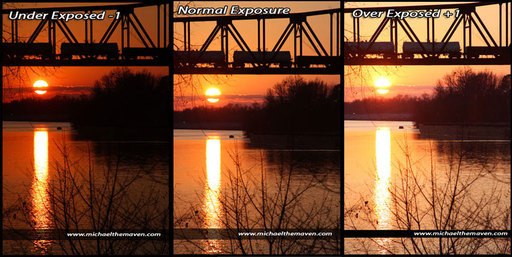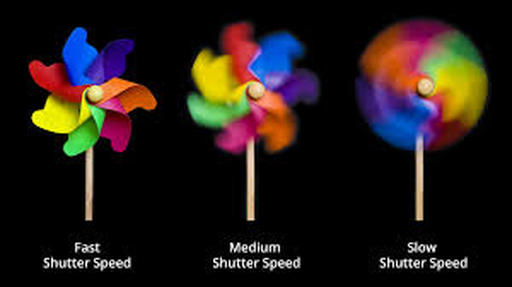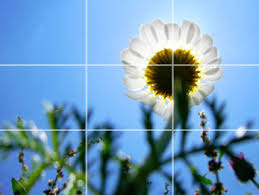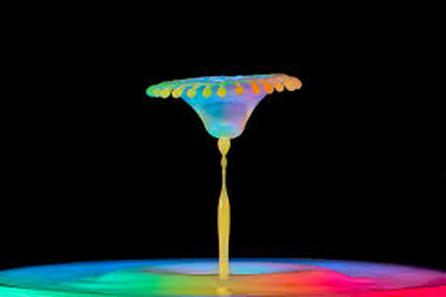EXPOSURE
|
In photography, exposure is the amount of light per unit area (the image plane illuminance times the exposure time) reaching a photographic film or electronic image sensor, as determined by shutter speed, lens aperture and scene luminance. Exposure is measured in lux seconds, and can be computed from exposure value (EV) and scene luminance in a specified region.
In photographic jargon, an exposure generally refers to a single shutter cycle. For example: a long exposure refers to a single, protracted shutter cycle to capture enough low-intensity light, whereas a multiple exposure involves a series of relatively brief shutter cycles; effectively layering a series of photographs in one image. For the same film speed, the accumulated photometric exposure (Hv) should be similar in both cases. |
|
In optics, an aperture is a hole or an opening through which light travels. More specifically, the aperture and focal length of an optical system determine the cone angle of a bundle of rays that come to a focus in the image plane. The aperture determines how collimated the admitted rays are, which is of great importance for the appearance at the image plane. If an aperture is narrow, then highly collimated rays are admitted, resulting in a sharp focus at the image plane. If an aperture is wide, then uncollimated rays are admitted, resulting in a sharp focus only for rays with a certain focal length. This means that a wide aperture results in an image that is sharp for things at the correct distance. The aperture also determines how many of the incoming rays are actually admitted and thus how much light reaches the image plane (the narrower the aperture, the darker the image for a given exposure time). In the human eye, the pupil is the aperture. |
APERTURE |
SHUTTER SPEED
|
Shutter speed is one of several methods used to control the amount of light recorded by the camera's digital sensor or film. It is also used to manipulate the visual effects of the final image.When a slower shutter speed is selected, a longer time passes from the moment the shutter opens till the moment it closes. More time is available for movement in the subject to be recorded by the camera as a blur.
A slightly slower shutter speed will allow the photographer to introduce an element of blur, either in the subject, where, in our example, the feet, which are the fastest moving element in the frame, might be blurred while the rest remains sharp; or if the camera is panned to follow a moving subject, the background is blurred while the subject remains relatively sharp. |
|
In photography composition is the arrangement of parts of a scene to form a particular visual outcome. Composition can also be about picking a viewpoint to form a pleasing visual outcome. In practical terms, thephotog tends to use both “arrangement” and “choice of viewpoint”.
In general composition aims to direct the viewer to see the point of the photograph. The “point” may simply be an aesthetically pleasing scene, or something containing a more complex story. Even a visually disturbing or discordant outcome are the result of efforts in composition. The finer points of a particular composition relies on a range of “photographic elements” and the “principles of photographic art” for using them. Elements of photographic artThe visual elements in a photo have attributes which are called the “photographic elements”. These are…
|
COMPOSITION |
RULE OF THIRDS |
The rule of thirds is a "rule of thumb" or guideline which applies to the process of composing visual images such as designs, films, paintings, and photographs.The guideline proposes that an image should be imagined as divided into nine equal parts by two equally spaced horizontal lines and two equally spaced vertical lines, and that important compositional elements should be placed along these lines or their intersections. Proponents of the technique claim that aligning a subject with these points creates more tension, energy and interest in the composition than simply centering the subject. |
|
In optics, particularly as it relates to film and photography, depth of field (DOF), also called focus range or effective focus range, is the distance between the nearest and farthest objects in a scene that appear acceptably sharp in an image. Although a lens can precisely focus at only one distance at a time, the decrease in sharpness is gradual on each side of the focused distance, so that within the DOF, the unsharpness is imperceptible under normal viewing conditions. In some cases, it may be desirable to have the entire image sharp, and a large DOF is appropriate. In other cases, a small DOF may be more effective, emphasizing the subject while de-emphasizing the foreground and background. In cinematography, a large DOF is often called deep focus, and a small DOF is often called shallow focus. |
DEPTH OF FIELD |
BALANCE |
Balance is a photography technique that involves capturing images within a frame so all parts of the image have equal visual weight. Proper balance should increase the visual appeal of a photograph. There are generally two types of balance, formal and informal. Formal balance is symmetrical balance. To achieve this type of balance, the focus of the picture should be placed in the middle of the image, while identical or similar subjects are evenly spaced around the central point. Portraits are an example of a picture where it is best to use formal balance. Informal balance is more indistinct in nature. In a photograph with informal balance, dissimilar elements balance each other out on either side of the frame. Informal balance can occur with objects of any size, but it is most visually appealing to have a larger object balanced out with a smaller object or several smaller objects. This type of balance usually follows the rule of thirds. |







